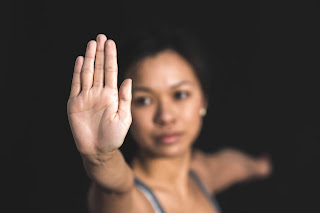How touch can mean different things to different people
How touch can mean different things to different people.
Who doesn’t like to feel wanted and desired? As human beings
it is a basic need to feel that connection and yet touch can mean different
things to different people depending entirely on the context it is given and
received in.
For example, at a work presentation a simple pat on the back
may be given from one colleague to another with the intention of showing
encouragement and yet the receiver feels it is a call for attention. When a
male officer worker is congratulated on his achievements by his female employer
with a gentle pat on the arm that action may be meant purely innocently but it
may be received by him or his colleagues as a sexual advance. It can be so easy
not only to misinterpret what others say and do but also touch can be
misinterpreted and often it can feel uncomfortable to clarify what exactly is
meant and so we draw our own conclusions which are not always accurate!
So how do we use touch? There are so many ways including to
comfort ourselves or others in the form of self-holding or an embrace , to get
attention in the form of a pat on the arm or shoulder, share things by passing
with our hands, saying hello or good bye with a hug, to feel connected by
holding hands with a loved one, to tease our spouse in a playful manner, and to
show ownership often seen with young couples by holding onto their partner
tightly to let everyone know that person is ‘mine’.
However we choose to touch another it is important to convey
the reason for the touch or it may be received in a different context to how it
was given. It is also important to note that not everyone is a naturally
tactile person some people simply do not feel comfortable with emotional displays
of affection, we are all different in how we perceive touch and experience it. Generally speaking as a whole women are more
comfortable to give and receive touch as they are genetically predisposed to be
the nurturers and therefore crave touch more than men who can easily feel
uncomfortable if the touch is too long as he may feel it threatens his masculinity.
However, it is always important to determine how approachable someone is in
advance to make sure that any form of touch will be accepted and welcomed. An
effective way to view this and to gauge if you feel touch will be received is
to watch how they are around others do they interreact openly with eye contact,
smiling and contact or prefer to keep a distance?
Men and women often
behave differently in social settings although not always of course. However,
it is very common for a woman to embrace her friends as a form of greeting and
it will be received and socially seen as showing warmth and connection whereby
the male touch can be experienced by a slight pat on the arm or back and
interpreted and seen as being powerful, dominant and paternal. It is also very
easy for a man to mistake a woman’s intentions because of the way society has
pre-programmed us to behave and think. For example, a friendly hug from a woman
to a man whether within a couple or as strangers may be given innocently and
yet received as a sexual advance or interest and the meaning behind the action
can therefore be easily misinterpreted!
Different cultures have different customs and what may seem
socially acceptable to us in one culture may not from a person in a different
culture and as a result it is always important to check local customs. For
example it is normal practice in many western countries to greet someone
formally with a handshake, whereby in some Asian countries you should only bow
or shake hands with someone who is equal to you in age or rank and you should
never use the left hand as that can be considered unclean. In addition to this,
touching the head is disrespectful in Buddhist culture as the head is
considered sacred being the highest part of the body , whereby the feet are the
lowest part of the body and therefore considered to be ‘dirty’.
In some cultures touch between members of the opposite sex
in a social setting can be frowned upon whereby touch and holding hands by members
of the same sex is acceptable and considered the norm. In some cultures for
example the UK we can be considered more ‘rigid’ and emotionally restrained in
comparison to people from Latin America who are much more open generally with
their gestures and touch.
Touch can often be given first by those in positions of
power or prestige. For example an employer interviewing a potential employee
may reach his hand out first for the hand shake or in other situations touch
may also be given but not reciprocated, in hospital a dr or nurse may examine
you , you may go to the dentist for a check-up or treat yourself to a massage.
We can also use touch to make our communication and feelings felt more
strongly, for example saying no whilst pushing someone away or nodding whilst
saying yes and giving someone a hug and therefore in the process amplifying our
verbal and nonverbal forms of communication at the same time.
Touch is therefore not just an action but a form of nonverbal communication from giver to receiver. It can convey a host of emotions which will depend on the message being conveyed which will range from feelings of comfort, trust and safety with the release of the hormone oxytocin when it is given with care and love to feelings of discomfort, fear or pain when it is given with aggression and hostility. Therefore, the power of touch should never be underestimated as once received it can be more powerful then may at first have been anticipated.




Comments
Post a Comment